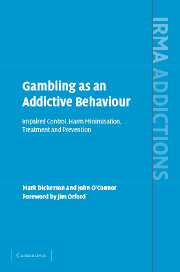Book contents
- Frontmatter
- Contents
- Preface
- Declaration
- Executive Summary
- Glossary
- Foreword
- List of Tables
- List of Figures
- 1 The Research Context
- 2 Research into Impaired Control of Gambling Behaviour, Definition and Measurement: Traditional Psychometric and Mathematical Psychology Approaches
- 3 Impaired Control and its Relationship to other Variables Implicated in the Development of Pathological Gambling
- 4 Models of Impaired Self-Control of Gambling
- 5 Implications for Treatment Approaches to Problem Gambling Arising from the Model of Impaired Control
- 6 Implications for Harm Minimisation in the Management of Problem Gambling: Making Sense of “Responsible Gambling”
- 7 A Case Study of “Responsible Gambling” Strategies within a Single Jurisdiction: Victoria, Australia
- 8 Conclusions
- References
- Index
6 - Implications for Harm Minimisation in the Management of Problem Gambling: Making Sense of “Responsible Gambling”
Published online by Cambridge University Press: 07 September 2009
- Frontmatter
- Contents
- Preface
- Declaration
- Executive Summary
- Glossary
- Foreword
- List of Tables
- List of Figures
- 1 The Research Context
- 2 Research into Impaired Control of Gambling Behaviour, Definition and Measurement: Traditional Psychometric and Mathematical Psychology Approaches
- 3 Impaired Control and its Relationship to other Variables Implicated in the Development of Pathological Gambling
- 4 Models of Impaired Self-Control of Gambling
- 5 Implications for Treatment Approaches to Problem Gambling Arising from the Model of Impaired Control
- 6 Implications for Harm Minimisation in the Management of Problem Gambling: Making Sense of “Responsible Gambling”
- 7 A Case Study of “Responsible Gambling” Strategies within a Single Jurisdiction: Victoria, Australia
- 8 Conclusions
- References
- Index
Summary
Harm Minimisation and Gambling
Harm minimisation has typically been defined as having the goal of reducing the “adverse health, social and economic consequences of drug (gambling) use without necessarily requiring abstinence … Harm reduction is pragmatic and humanistic, focused on harms and priority issues.” (Centre for Addiction and Mental Health in Canada, cited by Blaszczynski et al., 2001). Harm reduction includes a wide variety of strategies, ranging from public health oriented preventatives through to clinical interventions that focus on low-risk behaviours.
The application of the concept to gambling has possibly broadened the range of preventative strategies, which for gambling include consumer complaints mechanisms, codes for responsible marketing, gambling venue staff training, gambling information pamphlets, restricting venue placement of ATMs, design of gaming machine features and venue self-exclusion procedures. Noting that the terms of reference in which any social debate is framed may determine the scope and freedom in which policy debate can develop, Korn et al. (2003) argued that there were benefits from viewing gambling as a public health matter: “The value of a public health perspective is that it applies different ‘lenses’ for understanding gambling behaviour, analyzing its benefits and costs as well as identifying multilevel strategies and points of intervention.” (p. 236)
In this regard, the two national studies released in 1999, one from the USA and the other from Australia, provide a striking illustration of how limiting the debate to a preferred frame of reference or “lens” constricts the policy debate.
Information
- Type
- Chapter
- Information
- Gambling as an Addictive BehaviourImpaired Control, Harm Minimisation, Treatment and Prevention, pp. 107 - 123Publisher: Cambridge University PressPrint publication year: 2006
